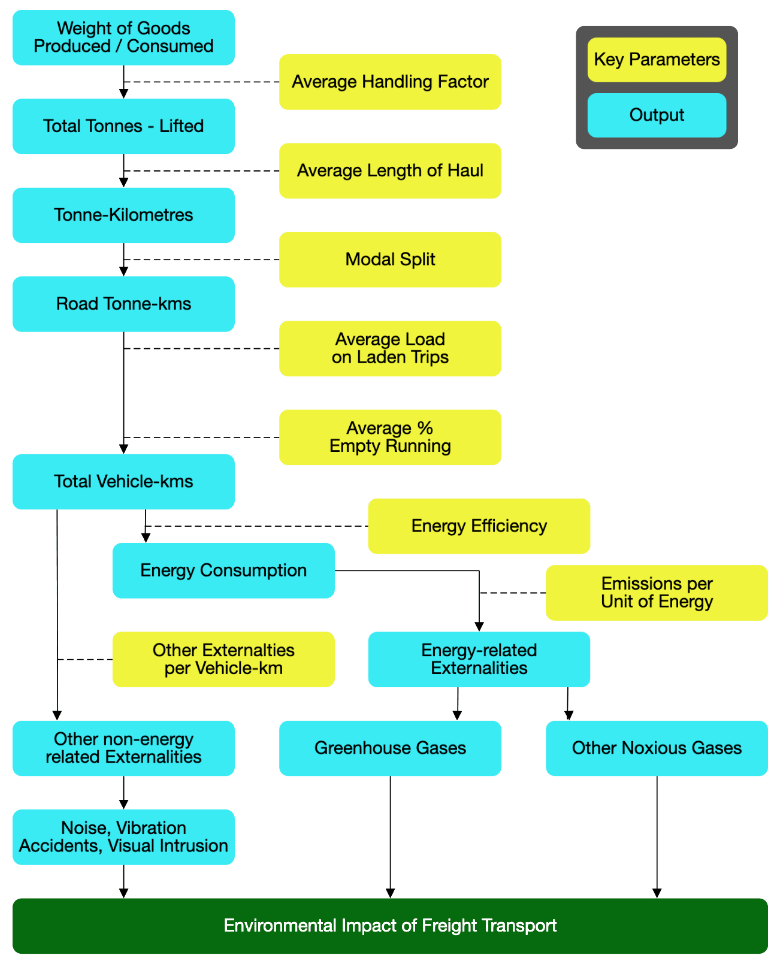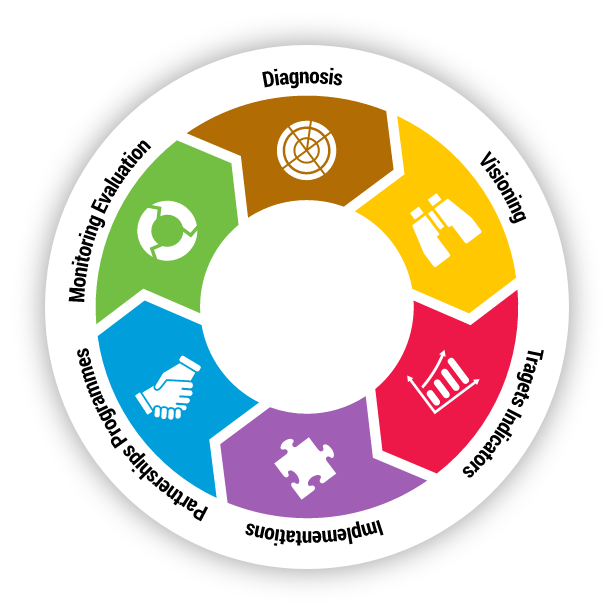The Implementation step moves the sustainable freight transport strategy development process from a conceptual level to a concrete and practical stage. During this step, efforts should aim to convert sustainable freight transport requirements identified during the diagnosis exercise (i.e. the agreed vision and the associated, goals, objectives and targets) into actual measures that promote sustainable freight transport.
Frameworks for identifying improvement measures and policies
Several frameworks can help identify relevant sustainable freight transport measures, policies, and instruments. These frameworks vary by geographical scope, source, nature and duration of the problem and the solution as well as the actors involved in the implementation process.After identifying and establishing the objectives through the prior steps, frameworks can offer a structure to define and scope potential measures towards meeting the objectives set. Below are several frameworks that can be deployed as part of the Implementation step, of which should be tailored to meet specific sustainable freight transport needs.
Avoid-shift-improve (ASI) framework
- "Avoid strategies": Aim to reduce the demand for freight transport that generates externalities. Relevant strategies may include cutting the quantity of cargo carried, the distances travelled, or both, as well as avoiding or reducing unnecessary freight transport activities and empty mileage.
- "Shift strategies": Aim to transfer freight transport activities to more energy-efficient and/or environmental-friendly modes. The shift reduces emissions per unit of freight transport activity (e.g. ton-kilometre).
- "Improve strategies": Aim to enhance system performance and cover freight transport infrastructure, services, and operations. Relevant “Improve” strategies may include infrastructure design changes, infrastructure development and maintenance, energy intensity reduction across the various freight transport modes (e.g. increased load factors or fuel efficiency), and, generally, any sustainability-driven improvements affecting vehicles, ships, equipment, transport operations, technologies, behaviour (e.g. changing drivers’ behaviour), etc.
Unlike in passenger transport where it is relatively well established and popular, the ASI Framework, in particular the "Avoid" element of the ASI Framework, appears to be less applied in freight transport. This is because countries may consider “Avoid” strategies that promote a reduction in freight transport demand, to be potentially detrimental to their economic growth and trade expansion. That said and while the correlation between economic growth, merchandise trade, and demand for freight transport is well established, experience in many developed countries shows that it is possible to decouple growth in the economy and freight transport activity, on the one hand, from growth in the associated externalities, on the other.
Green logistics framework
The Green Logistics Framework is particularly useful in linking economic growth with freight transport-related externalities, in particular the environmental externalities (Illustration 1 and centre column of Illustration 2). According to this framework, various levers interact to determine the level of externalities generated by a freight transport operation. These levers, which are set out below, are also associated with a set of parameters and outputs that are featured in Illustration 1. The yellow-shaded boxes contain the parameters while the blue-shaded boxes contain the outputs.

Illustration 1: Green Logistics Framework
According to the Green Logistics Framework, the main levers determining the externalities generated by freight transport include the following:
1. The structure of the supply chain
Relates to the location of the nodes and links through which the cargo/freight moves, and which determine the geographical patterns of cargo/freight flows. Some of the nodes (such as warehouses or freight terminals) may be located in environmentally sensitive areas and may need to be repositioned. There may also be an environmental benefit in consolidating cargo/freight flows along particular corridors where investment in rail infrastructure can be concentrated. Under this lever, key parameters include the average handling factor and the average length of haul.
2. Freight modal split
Refers to the allocation of cargo/freight traffic among transport modes, which is critical to any sustainable freight transport strategy. Some modes are ‘cleaner’ than others in terms of the externalities they generate per ton-kilometre of cargo/freight carried. Modes also differ, however, in their functionality and face different infrastructural, operational and technical constraints. This prevents the shift of all cargo/freight to the modes of transport that are more sustainable. Modes are also interdependent. The low density of the rail and waterway networks, for example, makes them dependent on feeder transport by road making the freight transport ‘intermodal’. Key parameters include the modal split.
5. Exposure to traffic congestion
Operating freight transport vehicles on congested roads carries a fuel penalty. Rescheduling deliveries to off-peak periods and optimizing freight transport planning/volume/operations contribute to cutting fuel consumption and emissions and ease the level of congestion for all types of traffic. Relevant parameters include average load on laden trips and average % empty running.
6. Energy efficiency
A more efficient operation of freight transport vehicles and ships translates directly into lower energy consumption, lower emissions, and greater resource-conservation. A set of mutually reinforcing technological, operational, and behavioural measures can be deployed to improve energy efficiency. Many of these can be supported by public policy.
7. Carbon and pollutant content of the energy source
Freight transport can be propelled by fuels that vary in terms of carbon and pollutant content. Switching to cleaner fuels is key. Electrifying freight transport and using other clean technologies such as alternative fuels and hybrid propulsion systems, can generate environmental benefits both at local and global levels. However, alternative and cleaner energy sources or and/or the required refueling/recharging infrastructure might not be readily available and accessible, especially in developing regions. In addition, the cost differential with conventional energy sources can hinder an effective fuel switch. A key parameter relates to the emission intensity or emission per unit of energy.
8. Other externalities per vehicle-km and per unit of throughput
Not all logistics-related externalities are a function of energy consumption. There are other effects such as noise, vibration, and accidents. This can be expressed either with respect to vehicle-km in the case of road transport or with reference to the throughput of warehouses, terminals, etc. A key parameter would be externalities per vehicle kilometre.
Identification of projects / strategies and prioritization
Once the framework that will be applied has been defined and the relevant sustainability levers have been identified, the next step is to identify potential projects, measures and policies that will address existing sustainability gaps and bottlenecks that prevail in the freight transport sector.
To identify the sustainability improvement measures and policies required, all impacts, including environmental and social, need to be expressed in monetary terms to reflect the external costs. The monetary value becomes the common metric used to estimate the impact of the unsustainable freight transport patterns. By assigning a monetary value to all externalities, it becomes possible to manage the externalities by taking relevant action to internalise the external costs.
Illustration 4: External Costs of Freight Transport in the EU-27 (Source: UNCTAD calculations, based on Marco Polo freight transport project proposals - EC Joint Research Centre, 2011).
Placing a monetary value on all the impacts of freight transportation, including the economic, social and environmental impacts, allows governments to, inter alia:
- Model the trade-offs between the economic, social and environmental objectives using a common metric.
- Conduct cost-benefit analyses of measures that reduce all types of impacts generated by the freight transport sector.
- Calculate a financial rate of return on investments made to improve the sustainability performance of freight transport.
- Estimate optimal subsidies for sustainable freight transport.
- Assess the amount of taxes to be levied on the freight transport sector/activities to recover the costs associated with the sector’s negative externalities.
Once the needs and gaps have been identified, sustainable freight transport improvement measures can be prioritised by using multi-criteria analytical tools such as PEST (Political, Economic, Social and Technological factors) or STEEP (Social, Technical, Economic, Ecological and Political) analysis. Multi-criteria analyses allow for multiple measures and actions to be proposed.
When identifying, prioritizing and implementing sustainable freight transport measures, the following considerations need to be taken into account:
Interconnections
Freight transport is strongly linked to trade and thus the implementation of relevant policies needs to accommodate trade-related plans and investments. Freight transport planning also intersects with other areas including land planning, city development, rural development plans and tourism, etc. This implies the emergence of potentially competing objectives and priorities and fragmented jurisdictions (e.g. city, district, state, national and regional authorities). As a result, implementing sustainable freight transportation requires, as a pre-condition, effective inter-agency coordination (e.g. on trade, customs, tourism, environment, infrastructure planning, transport, etc.). On the operational side, freight transport often shares the right of way with passenger transport. Therefore, the overall vision for both passenger and freight transport needs to be coherent taking into account development and investment plans relating to both areas of transport activity.
Private sector coordination
While selecting appropriate policies and strategies, it is important to acknowledge the timeframe mismatch that underpins the actions of the public and the private sector. Public authorities and the private sector usually operate according to different schedules. Owing to business concerns, the private sector requires clear long-term directions in terms of future regulatory and policy changes before it can make freight transport and logistics investment and operation decisions. It is therefore crucial to involve the private sector when defining, planning, and implementing sustainable freight transport strategies.
Freight transport is but one element of a logistics chain
Initiating and implementing sustainable freight transport measures entails implications that extend beyond the immediate scope of freight transport operations. The spillover effects could reach other areas of freight transport and storage activity with the overall net effect being potentially positive or negative. Hence, it is also important to examine the direct and indirect impacts of sustainable freight transport strategies on the freight transport sector.
Over 200 sustainable freight transport measures (or solutions) are compiled in the UNCTAD SFT Measures Catalogue (see Tool on UNCTAD SFT Measures). Eleven criteria/dimensions can be used to filter and select relevant measures. It is possible to navigate the overall catalogue by using the full text search function, which allows users to locate the measures that meet their specific needs. The relevant filters or selection criteria include the scope of the measure (e.g. company or regional levels), transport modes, investment costs and time horizon, and the externality mitigation potential.
Once the list of priority projects/measures/solutions is set and finalized, stakeholder consultations should be carried out to validate the selection. Interviews or focus group discussions can be relied upon to carry out these consultations. The main objective is to generate support for the projects and identify possible champions, i.e. stakeholders who could take the lead in the implementation of relevant measures and policies. Additionally, these consultations provide an opportunity to refine existing concepts and improve the list of projects and measures selected.
Each freight transport project, policy, measure or solution tends to be of particular relevance to a given audience, industry, grouping or stakeholder. For example, fuel economy standards play an important role from the perspective of heavy-duty vehicle manufacturers and trucking companies. Supply chain restructuring will have more relevance for shippers as they have a more influential role in this area. Carriers and freight transport service providers are usually the main stakeholders when dealing with technology retrofits. Consequently, and to cater to different stakeholders and audiences, outreach and consultation approaches need to vary depending on the target audience/stakeholder and the type of projects, measures and policies envisaged.
Priority projects and measures can be further validated by using quantifiable and flexible criteria (e.g. PEST/STEEP). This helps to guide the process aimed at identifying relevant sustainable freight transport measures, policies, investment decisions, and actions. The multi-criteria analysis approach under PEST or STEEP, for example, should be consistent with an existing data collection plan and resource availability.
The final priority list of sustainable freight transport projects, policies, measures or solutions, should be based on insights gained from both the qualitative and quantitative assessments carried out as well as from stakeholder consultations. It is important to integrate the identified and validated priority list into established transportation planning processes. This will ensure that they receive the same level of consideration as other aspects of transport planning, including passenger transport planning.
Following the prioritization process, an appropriate work plan needs to be developed. All stakeholders with a role in developing and implementing the sustainable freight transport strategy need to have a clear understanding of who does what and when. A work plan document should indicate all necessary milestones for implementing the strategy and should identify management procedures, tasks, and the corresponding responsible stakeholders.

